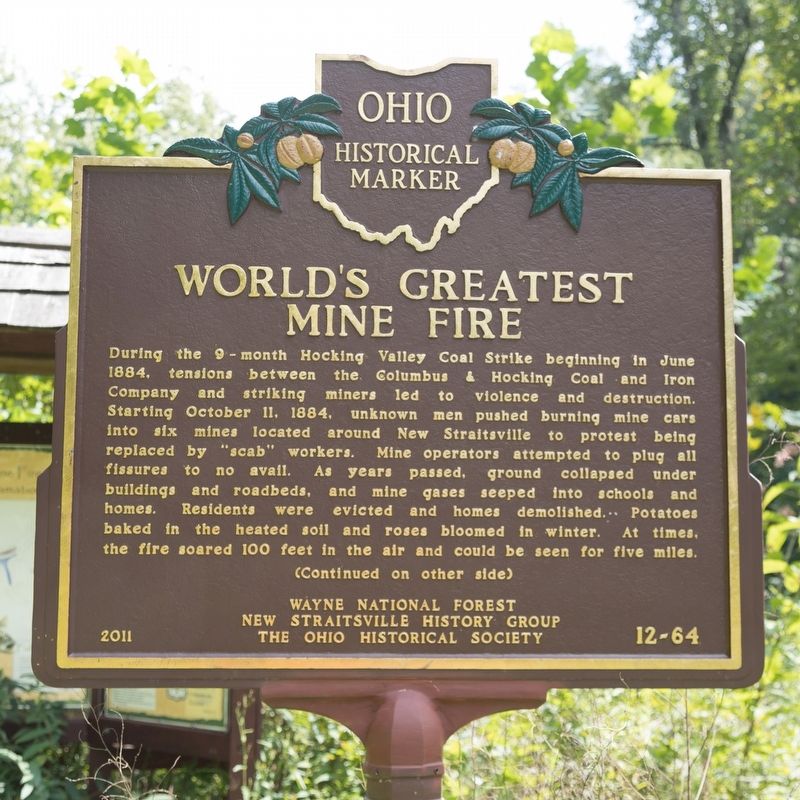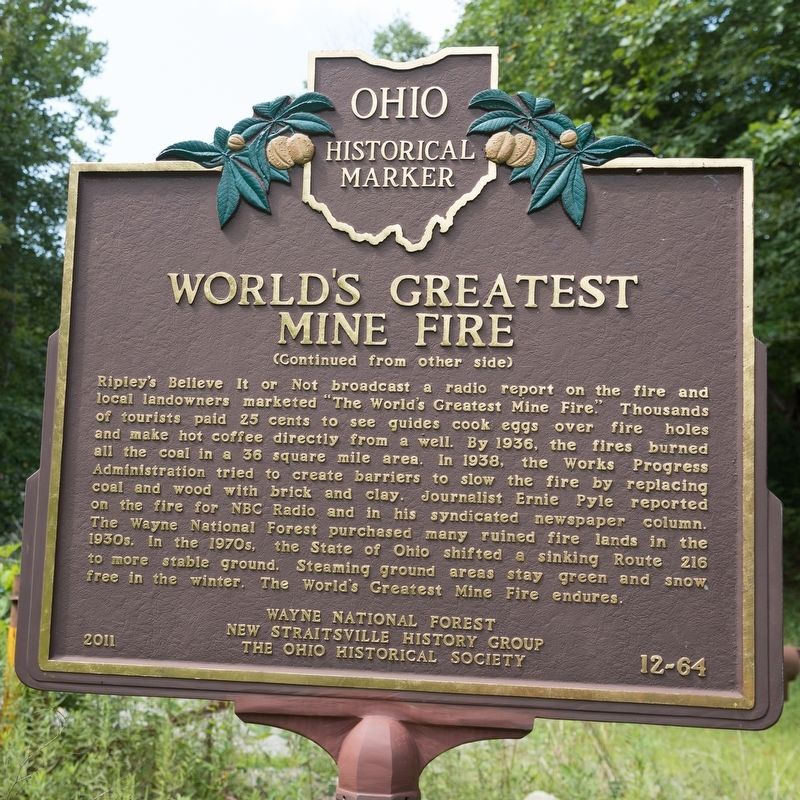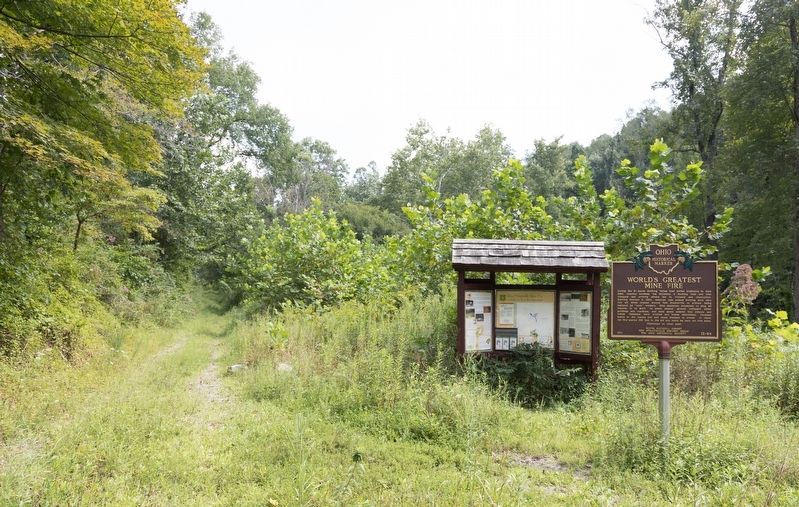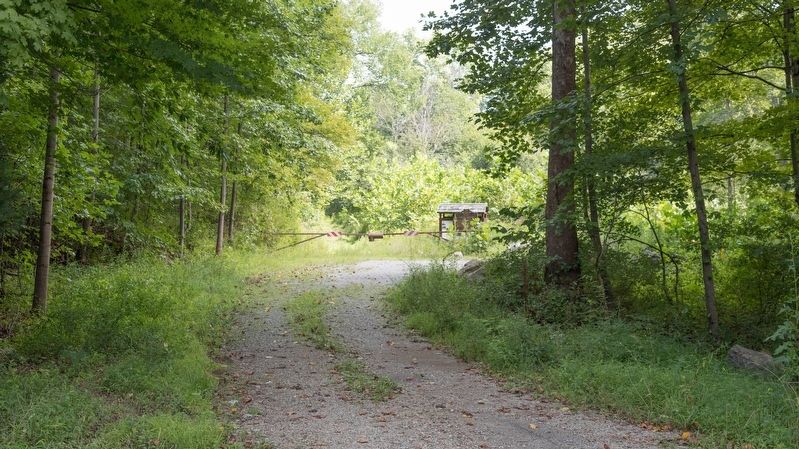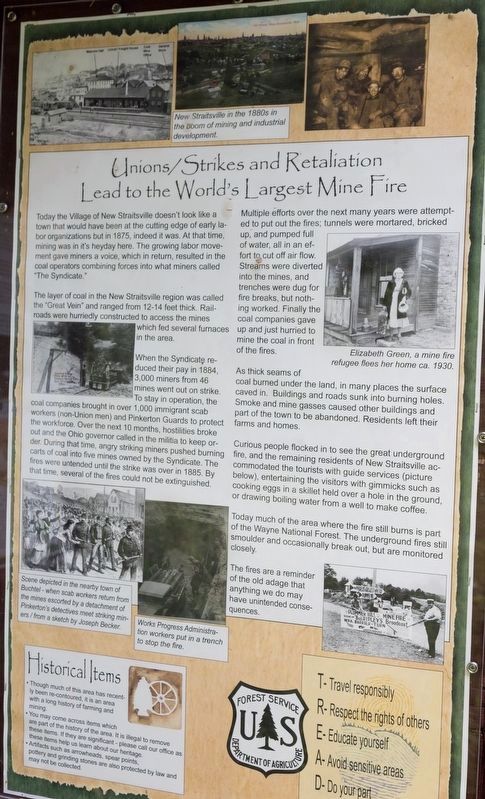Near New Straitsville in Perry County, Ohio — The American Midwest (Great Lakes)
World’s Greatest Mine Fire
During the 9-month Hocking Valley Coal Strike beginning in June 1884, tensions between the Columbus & Hocking Coal and Iron Company and striking miners led to violence and destruction. Starting October 11, 1884, unknown men pushed burning mine cars into six mines located around New Straitsville to protest being replaced by “scab” workers. Mine operators attempted to plug all fissures to no avail. As years passed, ground collapsed under buildings and roadbeds, and mine gases seeped into schools and homes. Residents were evicted and homes demolished. Potatoes baked in the heated soil and roses bloomed in winter. At times, the fire soared 100 feet in the air and could be seen for five miles.
Ripley’s Believe It or Not broadcast a radio report on the fire and local landowners marketed “The World’s Greatest Mine Fire.” Thousands of tourists paid 25 cents to see guides cook eggs over fire holes and make hot coffee directly from a well. By 1936, the fires burned all the coal in a 36 square mile area. In 1938, the Works Progress Administration tried to create barriers to slow the fire by replacing coal and wood with brick and clay. Journalist Ernie Pyle reported on the fire for NBC Radio and in his syndicated newspaper column. The Wayne National Forest purchased many ruined fire lands in the 1930s. In the 1970s, the State of Ohio shifted a sinking Route 216 to more stable ground. Steaming ground areas stay green and snow free in the winter. The World’s Greatest Mine Fire endures.
Erected 2011 by Wayne National Forest, New Straitsville History Group, and The Ohio Historical Society. (Marker Number 12-64.)
Topics and series. This historical marker is listed in these topic lists: Disasters • Industry & Commerce • Labor Unions • Natural Resources. In addition, it is included in the Believe It or Not, and the Ohio Historical Society / The Ohio History Connection series lists. A significant historical date for this entry is October 11, 1884.
Location. 39° 35.206′ N, 82° 13.417′ W. Marker is near New Straitsville, Ohio, in Perry County. Marker can be reached from the intersection of Ohio Route 93 and Rock Run Road (County Route 41), on the left when traveling south. It is as the trailhead and parking area for the Upper Rock Run Reclamation Site of the Wayne National Forest. Touch for map. Marker is in this post office area: New Straitsville OH 43766, United States of America. Touch for directions.
Other nearby markers. At least 8 other markers are within 2 miles of this marker, measured as the crow flies. New Straitsville Mine Fire and Rock Run Reclamation (here, next to this marker); Robinson’s Cave (approx. one mile away); A Little City in the Forest (approx. 1.3 miles away); Shawnee (approx. 1.3 miles away); Tecumseh Theater (approx. 1.3 miles away); Black Diamonds and Bricks (approx. 1.3 miles away); A Boom Town (approx. 1.3 miles away); Welcome to Shawnee and the Little Cities of Back Diamond Region (approx. 1.3 miles away). Touch for a list and map of all markers in New Straitsville.
Regarding World’s Greatest Mine Fire. Known as The New Straightville Mine Fire, it has been burning since 1884. Smoke still emerges from the soil of the Wayne National Forest.
Also see . . .
1. New Straitsville Mine Fire. Ohio History Central website entry (Submitted on July 14, 2022, by Larry Gertner of New York, New York.)
2. New Straitsville Mine Fire.
Additional commentary.
1. Information on the posters in the informational kiosk directly behind the marker.
New Straitsville Mine Fire Site.
This site, known as the "World's Greatest Mine Fire" is a part of the Wayne National Forest, located on the Athens Ranger District, and managed by the US Forest Service, Department of Agriculture.
A reclamation project begun in 2010 has changed the face of this area. Plans for an interpretive trail and other developments will come as funding allows.
When violence and destruction broke out during the 9-month Hocking Valley Coal Strike in 1884 no one could envision the long term devastation to the area that would result.
Coal in the underground mines caught fire, and has been burning ever since. No one is sure how many square miles of underground mines may have burned but the fire continues to occasionally reach the surface yet today.
Unions/Strikes and Retaliation Lead to the World’s Largest Mine Fire.
Today the Village of New Straitsville doesn't look like a town that would have been at the cutting edge of early la¬bor organizations but in 1875, indeed it was. At that time, mining was in its heyday here. The growing labor movement gave miners a voice, which in return, resulted in the coal operators combining forces into what miners called “The Syndicate.”
The layer of coal in the New Straitsville region was called the “Great Vein” and ranged
from 12-14 feet thick. Rail¬roads were hurriedly constructed to access the mines which fed several furnaces in the area.
When the Syndicate reduced their pay in 1884, 3,000 miners from 46 mines went out on strike. To stay in operation the coal companies brought in over 1,000 immigrant scab workers (non-Union men) and Pinkerton Guards to protect the workforce. Over the next 10 months hostilities broke out and the Ohio governor called in the militia to keep order. During that time, angry striking miners pushed burning carts of coal into five mines owned by the Syndicate. The fires were untended until the strike was over in 1885. By that time, several of the fires could not be extinguished.
Multiple efforts over the next many years were attempted to put out the fires; tunnels were mortared, bricked up, and pumped full of water, all in an ef¬fort to cut off air flow. Streams were diverted into the mines, and trenches were dug for fire breaks, but noth¬ing worked. Finally the coal companies gave up and just hurried to mine the coal in front of the fires.
As thick seams of coal burned under the land, in many places the surface caved in. Buildings and roads sunk into burning holes. Smoke and mine gasses caused other buildings and part of the town to be abandoned. Residents left their farms and homes.
Curious people flocked in to see the great underground
fire, and the remaining residents of New Straitsville accommodated the tourists with guide services, entertaining the visitors with gimmicks such as cooking eggs in a skillet held over a hole in the ground, or drawing boiling water from a well to make coffee.
Today much of the area where the fire still burns is part of the Wayne National Forest. The underground fires still smolder and occasionally break out, but are monitored closely.
The fires are a reminder of the old adage that anything we do may have unintended consequences.
Devastation to Destination.
This project, with help from Recovery Act money, took a devastated area and moved it to a destination place for Forest visitors. This area overlaid a collapsing underground mine which allowed water to infiltrate in and out of the acidic coal passages, creating acid mine drainage. The water was diverted to keep the water from entering the underground mines and becoming acidic.
Over the last 15 years, the Wayne National Forest and their partners have worked to restore the 75,000 acre Monday Creek Watershed. For nearly a century, the aquatic life that once thrived in this watershed had been virtually dead. Today, due to restoration efforts, the 27 mile long stream has 13 species of fish.
In 2009, the Ohio Environmental Protection Agency (OEPA) reversed their designation of Monday Creek from non-restorable to having warm water habitat status. This success is due to many agencies sharing expertise, workload, and funding to bring back this important watershed.
The work could not have been possible without the support of the people in the communities along Monday Creek who have participated in volunteer initiatives.
— Submitted September 2, 2018.
Credits. This page was last revised on July 14, 2022. It was originally submitted on September 2, 2018, by J. J. Prats of Powell, Ohio. This page has been viewed 5,480 times since then and 968 times this year. Photos: 1, 2, 3, 4, 5. submitted on September 2, 2018, by J. J. Prats of Powell, Ohio.
